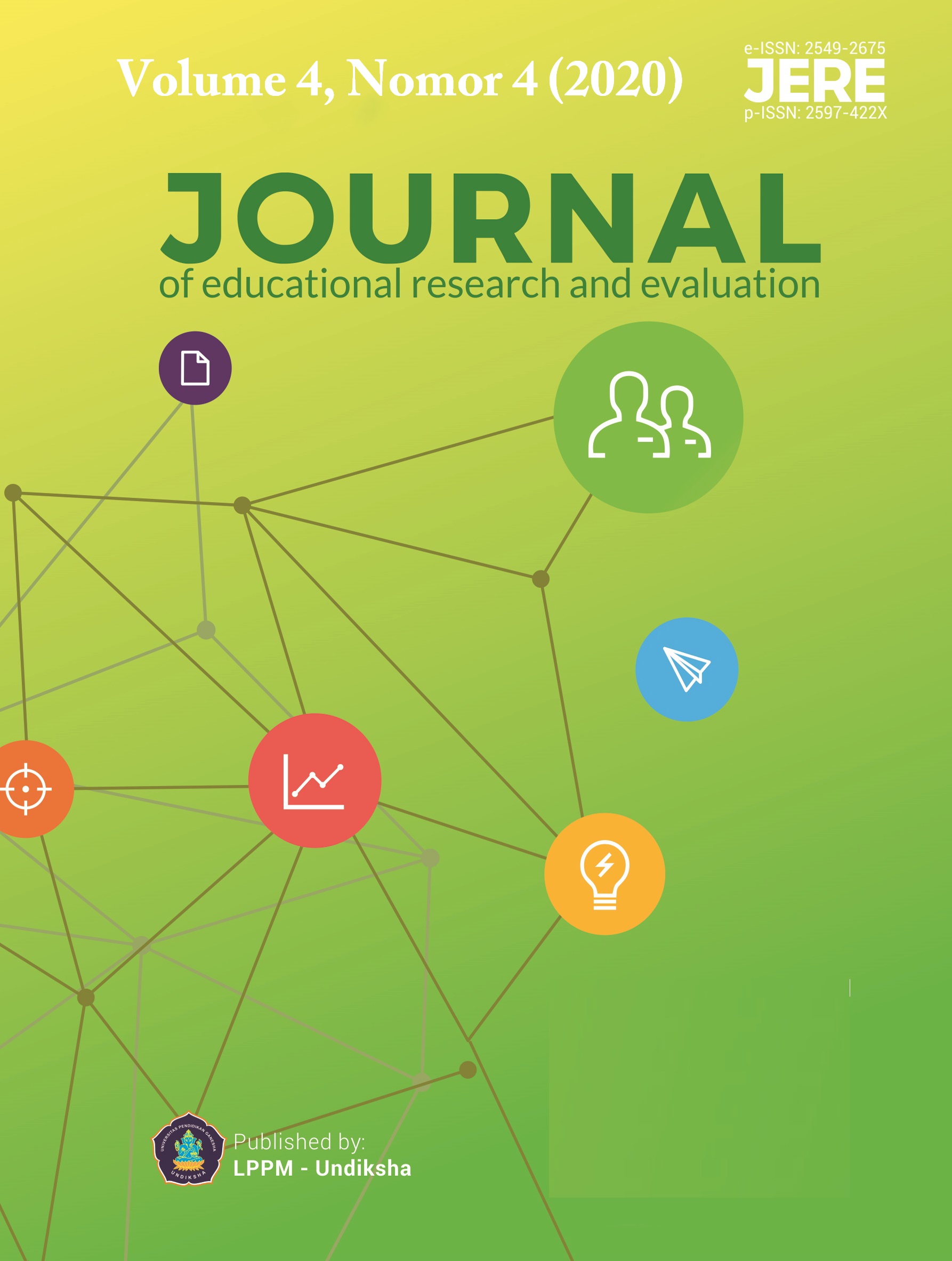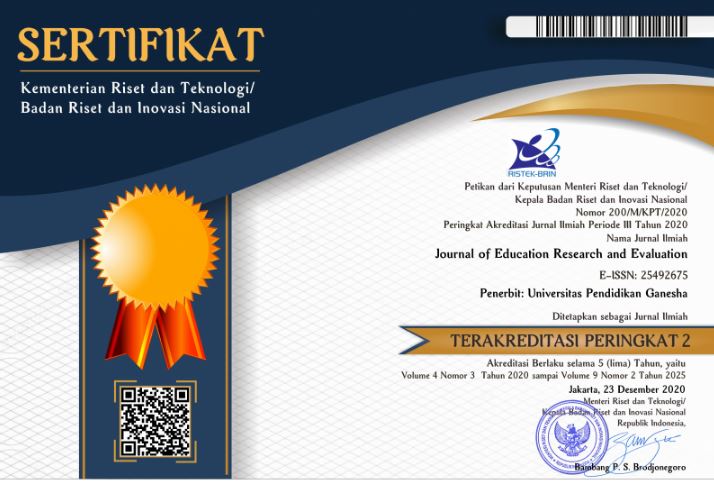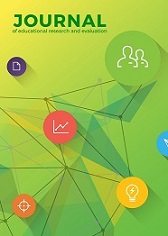Mixed Codes in Mindy Cake & Cookies Recipe Book by Mindy Mot
DOI:
https://doi.org/10.23887/jere.v4i4.29100Abstract
This study aims to find out understanding and analyzing the forms of code mixing, the types and factors of code mixing happened in this book was written by Mindy Mot. The technique of data collection used literate study. The method of this research used descriptive qualitative method. The object of this research is “The Mindy Cake & Cookies” as a recipe book written by Mindy Mot. The result showed that there were words and phrases form of code mixing in the recipe book “Mindy Cake & Cookies” by Mindy Mot. The type of code mixing in this book was named as code mixing out. In this book, there was no mixed code found because Mindy Mot did not insert the regional languages in her book. The writing of the recipe book used Indonesian which was inserted into English therefore it was found an only code mixing out. The factors caused the mixing of codes in “Mindy Cake & Cookies” recipe book by Mindy Mot are the perception of the author’s language background, language dominance, language attitude, psycholinguistic motivation, commercialization for the target market.
References
Appel, R., & Muysken, P. (2005). Language contact and bilingualism. Amsterdam University Press.
Ardiyanti, D., & Setyorini, R. (2018). Analisis Campur Kode pada Lirik Lagu Jaran Goyang Dipopulerkan oleh Nella Kharisma. SAP (Susunan Artikel Pendidikan), 2(3). https://doi.org/10.30998/sap.v2i3.2451
Aritonang, D. R., Solin, M., & Parapat, L. H. (2019). Pengembangan Kosa Kata Melalui Keterampilan Menulis Akademik Untuk Mengatasi Masalah Campur Kode Mahasiswa. Linguistik: Jurnal Bahasa Dan Sastra, 4(2), 120–130. https://doi.org/10.31604/linguistik.v4i2.120-130
Arni, A. (2016). Variasi Alih Kode Dan Campur Kode Dalam Masyarakat Dwibahasa Kajian Sosiolinguistik Pada Masyarakat Madura Di Kota Pontianak Kalimantan Barat. Jurnal Pendidikan Bahasa, 3(1), 43–57. https://doi.org/10.31571/bahasa.v3i1.174
Chaedar, A. (1985). Sosiologi Bahasa. Angkasa.
Dewi, R. (2020). Campur Kode dalam Proses Pembelajaran Bahasa Indonesia di SMA Negeri 1 Rantepao. Jurnal Ilmiah Wahana Pendidikan, 6(3), 432–441. https://doi.org/10.5281/zenodo.3980783
Fajriansyah, N. B., Sopianda, D., & Kartini, C. (2018). Alih Kode Dan Campur Kode Pada Film Romeo & Juliet Karya Andibachtiar Yusuf. Jurnal Pendidikan Bahasa Dan Sastra Indonesia, 1(4), 563–570. https://doi.org/10.22460/p.v1i4p563-570.952
Fathurrohman, H. R., Sumarwati, S., & Hastuti, S. (2019). Bentuk Dan Fungsi Campur Kode Dan Alih Kode Pada Rubrik “Ah... tenane” Dalam Harian Solopos. Jurnal Penelitian Bahasa, Sastra Indonesia, Dan Pengajarannya, 1(2), 207–222. https://www.neliti.com/publications/54857/bentuk-dan-fungsi-campur-kode-dan-alih-kode-pada-rubrik-ahtenane-dalam-harian-so
Gayatri, N. L. A., Sudiana, I. N., & Indriani, M. S. (2016). Alih Kode Dan Campur Kode Guru Dalam Pembelajaran Bahasa Indonesia Kelas VII SMP Negeri 4 Kubutambahan. Jurnal Pendidikan Bahasa Dan Sastra Indonesia Undiksha, 4(2). https://doi.org/10.23887/jjpbs.v4i2.8141
Khoirurrohman, T., & Anjany, A. (2020). Alih Kode Dan Campur Kode Dalam Proses Pembelajaran Di Sd Negeri Ketug (Kajian Sosiolinguistik). DIALEKTIKA Jurnal Pemikiran Dan Penelitian Pendidikan Dasar, 10(1), 362–370. https://journal.peradaban.ac.id/index.php/jdpgsd/article/view/518
Kurniasih, D., & Zuhriyah, S. A. (2017). Alih kode dan campur kode di Pondok Pesantren Mahasiswa Darussalam. Indonesian Language Education and Literature, 3(1), 53–65. https://doi.org/10.24235/ileal.v3i1.1521
Laiman, A., Rahayu, N., & Wulandari, C. (2018). Campur Kode Dan Alih Kode Dalam Percakapan Di Lingkup Perpustakaan Universitas Bengkulu. Jurnal Ilmiah Korpus, 2(1), 45–55. https://doi.org/10.33369/jik.v2i1.5556
Mansoer, P. (1987). Sosiolinguistik. Angkasa.
Masitoh, S. (2013). Campur Kode Bahasa Indonesia ke dalam Bahasa Jawa pada Siaran Radio Jampi Sayah di Radio SKB POP FM Gombong. ADITYA-Pendidikan Bahasa Dan Sastra Jawa, 3(1), 28–33. http://ejournal.umpwr.ac.id/index.php/aditya/article/view/662
Moleong, J. (2017). Metodologi Penelitian Kualitatif. Pt Remaja Rosdakarya.
Mustikawati, D. A. (2016). Alih Kode dan Campur Kode Antara Penjual dan Pembeli (Analisis Pembelajaran Berbahasa Melalui Studi Sosiolinguistik). Jurnal Dimensi Pendidikan Dan Pembelajaran, 2(2), 23–32. https://doi.org/10.24269/dpp.v2i2.154
Padmadewi, N. N., Merlyna, P. D., & Saputra, N. P. H. (2014). Sosiolinguistik. Graha Ilmu.
Pranowo. (2014). Teori Belajar Bahasa: Untuk Guru dan Mahasiswa Jurusan Bahasa. Pustaka Pelajar.
Rulyandi, R., Rohmadi, M., & Sulistyo, E. T. (2014). Alih Kode dan Campur Kode dalam Pembelajaran Bahasa Indonesia di SMA. Paedagogia, 17(1), 27–39. https://doi.org/10.20961/paedagogia.v17i1.36030
Setiadi, D. (2017). Campur Kode Dalam Lirik Lagu “Kis Band.” RETORIKA: Jurnal Ilmu Bahasa, 3(1), 1–15. https://doi.org/10.22225/jr.3.1.92.1-15
Simatupang, R. R., Rohmadi, M., & Saddhono, K. (2019). Tuturan dalam pembelajaran Bahasa Indonesia (kajian sosiolinguistik alih kode dan campur kode). Kajian Linguistik Dan Sastra, 3(2), 119–130. https://doi.org/10.23917/kls.v3i2.5981
Sugiyono. (2014). Metode Penelitian Pendidikan Pendekatan Kuantitatif, Kualitatif, dan R&D. Alfabeta.
Sugiyono, S., & Widodo, M. (2017). Alih Kode Dan Campur Kode Di Lingkungan Sma Negeri 1 Pagelaran. J-SIMBOL (Bahasa, Sastra, Dan Pembelajarannya), 5(1). http://jurnal.fkip.unila.ac.id/index.php/BINDO/article/view/12336
Suwandi, S. (2010). Serba Linguistik (Mengupas Pelbagai Praktik Bahasa). Universitas Sebelas Maret Press.
Downloads
Published
How to Cite
Issue
Section
License
Authors who publish with the Journal of Evaluation and Research in Education (JERE) agree to the following terms:
- Authors retain copyright and grant the journal the right of first publication with the work simultaneously licensed under a Creative Commons Attribution License (CC BY-SA 4.0) that allows others to share the work with an acknowledgment of the work's authorship and initial publication in this journal.
- Authors are able to enter into separate, additional contractual arrangements for the non-exclusive distribution of the journal's published version of the work (e.g., post it to an institutional repository or publish it in a book), with an acknowledgment of its initial publication in this journal.
- Authors are permitted and encouraged to post their work online (e.g., in institutional repositories or on their website) prior to and during the submission process, as it can lead to productive exchanges, as well as earlier and greater citation of published work. (See The Effect of Open Access)











